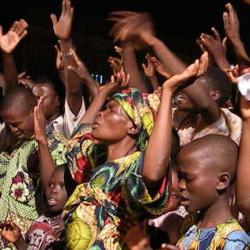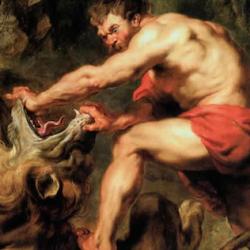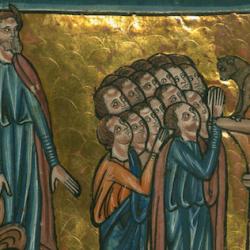Several interesting articles in the current issue of JSOT :
1) Yairah Amit of Tel Aviv University writes on “Progression as a Rhetorical Device in Biblical Literature.” The concept is fairly simple: He’s pointing to places where, in narrative or speech, the biblical writers list a series of events or points, which progress toward a climax (or a nadir). Progression arranges the elements of the text in “an ascending or descending order: from the general to the particular, or vice verse; from minor to major, or the reverse; from the expected to the unexpected; the impersonal to the personal, and so on. Often the final step in the progression is the climactic one, while each of the preceding steps plays its part in expanding or narrowing the sequence, and thereby shedding more light on the subject” (p 9).
Some of Amit’s examples are particularly illuminating. He points out, for example, the sequence in the account of the results of the battle of Aphek in 1 Sam 4: Israel is routed, many die, the ark is taken, and Eli’s sons are killed (vv 10-11). This follows the same order as the introduction to the battle in vv 2-4, which records another defeat of Israel, the fact that many were killed, and then indicates that the ark was brought by the priests (vv 2-4). Thus, these two progressions form an inclusio around the account of the battle. But within that inclusion, there is a sharp contrast between expectation and result, particularly in the last two elements of the sequence: the arrival of the ark and priests in vv 2-3 evokes hope of victory, but the climax of the story shows the ark in captivity and the priests dead. The same events are found in the announcement to Eli later in the account, but the order of the last two elements is changed: Israel fled, a great slaughter, sons dead, ark taken. And it is the last element that causes Eli to topple from his seat and break his neck.
Another interesting example is the story of Delilah and Samson (Judg 16:4-21). There is no progression apparent in Samson’s lies about the source of his strength, but there is an increasingly manipulative and aggressive response from Delilah. At first, she asks politely to know her lover’s secret; then she complains, but still politely; the third response is more aggressive and vigorous, and lacks the polite touches Delilah deployed earlier; finally, she questions Samson’s love for her, which causes him finally to give in.
2) Ronald Bergey traces the intertextual links between the Song of Moses in Deuteronomy 32 and the prophecy of Isaiah, particularly chapters 1, 5, 28, 30. He is excruciatingly careful about assessing the verbal parallels, and makes a good case that Deuteronomy 32 plays a “compositional role” in Isaiah’s prophecy and that Deuteronomy influenced Isaiah rather than the reverse. This has important implications for the dating of Deuteronomy, the hinge of the documentary hypothesis (which still, astonishingly, has wide acceptance). It may also have a number of interesting implications for NT theology. NT Wright has argued that the latter chapters of Deuteronomy provide a narrative subtext for much of Paul’s theology, and showing that Isaiah is expanding on Deuteronomy (at least at some points) could enrich the background of Paul’s teaching. Working in the opposite direction: Baker is publishing a series of volumes examining the influence of Isaiah’s “new exodus” theme on the gospels and Acts, and noting the links with Deuteronomy 32 would enrich our understanding of the gospels. Putting these two together, seeing the links between the two OT texts might be an important aspect of an effort to show the continuity between the gospels and Paul.
3) Keith Bodner offers what in my judgment is an unsuccessful treatment of the role of Eliab, David’s older brother, in 1 Sam. Eliab is the brother who appears before Samuel, and is also the brother who rebukes David when the latter inquires about the reward for defeating Goliath. Bodner says that Eliab’s narrative role is to reveal (to the reader) complexities and dark corners of other characters. In particular, his harsh rebuke to David, that he has an “evil heart,” is partly true, or at least a warning to us that David is not so squeaky clean as he might appear. I’m not at all persuaded, partly because this interpretation relies on recent work that presents a much more negative picture of David than the Bible itself does (“David’s secret demons,” and all that). When a scholar finds things troubling in David’s actions that the biblical writers do NOT find troubling, we seem to have reason to suspect that the scholar is bringing his own sensibilities to the text rather than explaining what the ancient writer wanted to convey. Some modern scholars don’t like David, and find him unnerving; but they shouldn’t pretend that the biblical writers thought the same. Further, Bodner’s treatment misses a crucial element of the typology in this section of Samuel. David is being presented as a new Joseph: the youngest son in a family dominated by males; he is successful and “acts wisely” in his service to Saul (ch 18), but is persecuted unjustly; and, his brother attacks him when he offers to take care of the giant, as Joseph’s brothers resented and attacked him. Bodner perhaps would respond by defending Reuben, Simeon, and the rest, or be suggesting that the character of Joseph is as “artfully complex” as David’s. It’s far more plausible that the writer of Samuel surrounded David with an aura of Joseph-ness to commend the young hero, and to present him as a “savior” of Israel. Bodner’s article is a good example of how literary-critical treatments of the Bible can go astray, mainly by assessing biblical narratives as if the writers had the same literary interests as modern novelists.
4) L. Daniel Hawk has a fascinating article on the parallels between the Oresteia and the account of the rise of Israel’s monarchy. I want to read this one more carefully before summarizing it, however.















